So we are up and running because Dean Irwin from CCCU has today given the first of the FREE Lunch Time Lectures which was absolutely excellent. More on that anon, but to say next week our speaker at 1pm on Wednesday will be Dr Daniella Gonzalez whose talk is entitled ‘Conceptualising Common Profit in Late Medieval London: the Jubilee Book, a Case Study’.
As this week it will be on Teams Live Events and the joining url is: https://teams.microsoft.com/l/meetup-join/19%3ameeting_YjM4MjJmYWItNzFlYy00MzIyLWFjMjAtZTYzNDkzOTBiMDVm%40thread.v2/0?context=%7b%22Tid%22%3a%220320b2da-22dd-4dab-8c21-6e644ba14f13%22%2c%22Oid%22%3a%225438ffb7-ff66-44f6-9ccf-cf504309571b%22%2c%22IsBroadcastMeeting%22%3atrue%7d
This means you do not need to book and I hope this will help those unfamiliar with Teams. Join about 5 to 10 minutes before start time – see joining url above: to join Teams (as you would for Zoom) click on the link or paste in your web browser. Then on the screen click on ‘Open Microsoft Teams’ (centre, top in the little panel, not the buttons in the middle of the screen). Then to get you into the lecture as an attendee click ‘Join now’ (as you would for Zoom).
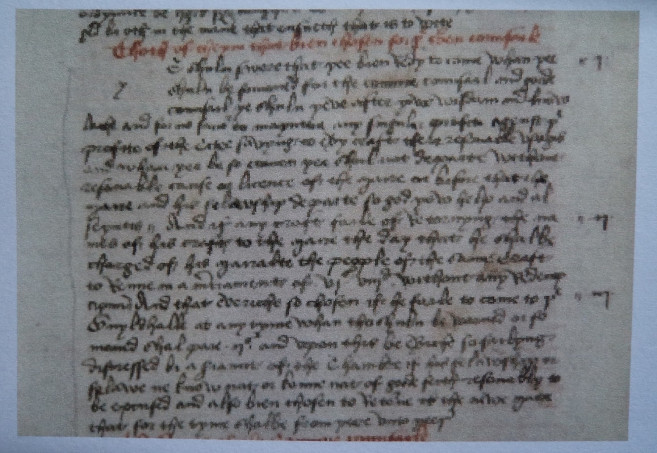
In case you haven’t caught the blog before, these lectures are a joint venture between the Friends of Canterbury Cathedral, the Centre for Kent History and Heritage at CCCU, and the Canterbury Association of Medieval and Early Modern Studies (CAMEMS) with MEMS at Kent to showcase the work of postgraduates and post-doctoral students from the two universities in Canterbury. Dr Gonzalez completed her doctorate at the University of Kent and she is also a Co-founder of MEMSLib, an online lockdown library created during the Covid-19 pandemic to help scholars continue researching throughout this time.
This week before I come to Dean’s lecture on a tale of two London (medieval) Jews, I will give a brief summary of the activities of the members of the Kent History Postgraduates group who met today for the first time in 2021. The group is now up to twelve, which is absolutely brilliant, and everyone was there today. This summary is in no particular order. Victoria started work on a part-funded MA by Research project on the St Albans Court inventory in the autumn, but due to work commitments she has only now been able to really get going. Currently she is entering the information from the catalogue of the library’s books into a spread sheet preparatory to starting work on identifying themes within the collection, such as does there seem to have been a strong owner interest in the choices made. Victoria also thanked Dean for his suggestion of a recent doctoral thesis from Manchester, which has proved extremely useful, and she is gradually building up her own library about book collecting. This is becoming a very exciting project, as, of course, are all the others mentioned here.
Due to the COVID situation, Tracey has had more time recently to work on her thesis, although this is a two-edged sword because archives remail closed. She has been investigating Agnes de Cundy, a member of the late 12th/early 13th century aristocracy who married into the great Clifford family. Agnes’ will is extremely interesting due in part to her desire to be buried in Canterbury cathedral and, even though she held very little land in Kent, her holdings elsewhere were very extensive. Although she was of far higher status than the knightly women who are Tracey’s primary focus, she will provide a valuable comparative study regarding lay piety and female patronage in the High Middle Ages.
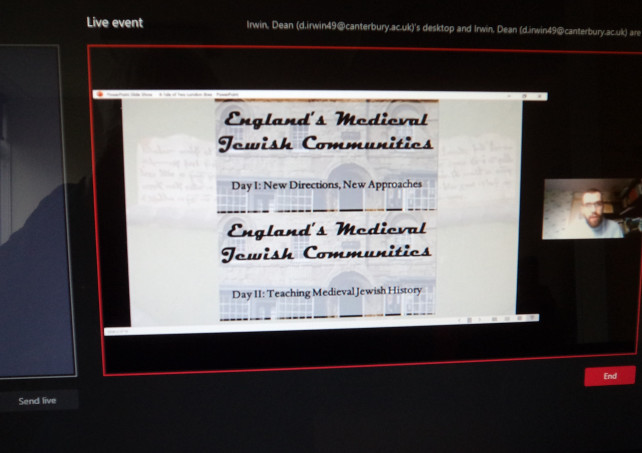
Going west to Tonbridge, Maureen has been investigating wills from Sevenoaks for Charles II’s reign to provide some comparative material for her Tonbridge wills for the same period. Even though the Tonbridge ones are from the PCC rather than the Rochester diocesan courts, which means in broad terms the testators are likely to have been wealthier than the Sevenoaks ones, it is interesting that 50% of the Tonbridge will-makers included bequests to the poor compared to 25% from Sevenoaks. Maureen has also been heartened by her trawl through various online catalogues which have revealed more sources when these archives reopen.
Keeping with Tonbridge, Jane has had considerable family and other matters to deal with recently, but she is starting to pick up her research again. She mentioned that she has been trying to recover her bibliographical references and this sparked a discussion about how other people kept these sources, a discussion that brought a whole range of suggestions and the same topic came up again later in the meeting in response to Grace’s contribution. Additionally, Jane has returned to working on the Culpepper family as one of her case studies. She has also signed up to give a paper at the International Medieval Congress in the summer, which as last year will be online.
Crossing to the archaeologists, Lisa is currently finishing her assignments for a university teaching course, but regarding her doctorate, she is in a very fortunate position. Having completed her data collection on the 150 skeletons from late Roman cemeteries around Canterbury at Canterbury Archaeological Trust, she is now in a position to start on the data analysis. She has also been taking part in several online conferences and workshops. However, the lockdown is hampering her access to the grey literature and to secondary sources more broadly.
Richard is at a much earlier stage in his doctoral journey and is currently continuing to work through the background reading preparatory to writing his literature review. He has decided he wants people in his landscape and the three groups he will be focusing on for 5th to 7th century Kent are the metal workers, the farmers and the elite. He is getting very interested in the technology of metal working. In response, Janet has offered to send his information from the Scadbury archaeological excavations, thereby demonstrating yet again how well this group collaborates to help one another.
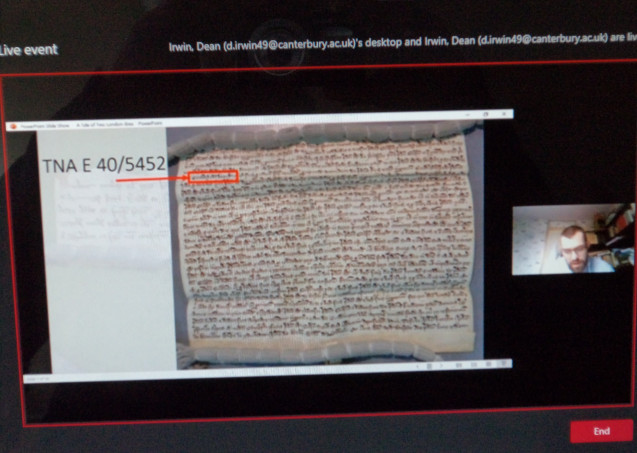
As note earlier, Grace revived the debate concerning how best to bring together the historiography so that this element can be built up without too many problems during the life of the doctoral project. Like Richard, she is near the beginning of this journey and is finding it challenging to bring the many disparate threads into order. However, as several people said, this is not unusual and it will fall into place over time, especially once you start on your own research.
In some ways at the other end of her project, Janet is due to submit this year, she too is hampered by the lack of access to archives, in her case TNA and CCAL. However, she has been investigating further the 13th-century windmill in St Paul’s Cray that has involved old maps and looking closely at the topography on the ground. This in some ways has proved to be less frustrating than working on her ‘Picture this ..’ article which rather needs an image of a particular pilgrim badge – currently locked away in The Beaney!
Jacie similarly has been hampered by the lockdown, as well as the strains relating to work and her research. However, she very kindly volunteered to give the presentation in a fortnight’s time so here I’ll only say she has been working on the history of emotions.
This brings me to the three people who have completed/submitted their research studies. Having her doctorate, Lily is currently working on an article, which is now at the completed draft stage; Peter having gained his MA by Research and then working flat out for the CCCU chaplaincy team is having a well-earned rest, while Dean having submitted his doctorate is working on a couple of articles, editing a special issue and co-convening an online conference, having had time over Christmas to celebrate properly submitting his thesis as only students know how!
Keeping with Dean, I now want to move to his talk today on two London Jews, Rabbi Elias de Menahem and Cresse son of Genta who lived through a period (1241 to 1255) when Henry III and his brother extracted about 110,000 marks from the Jewish community in the form of tallages. Now this wasn’t the subject of his talk but what the tallage payment records do highlight is that the community comprised three groups: the great, the middling, and the poor. This is important because, as Dean pointed out, nearly all the historiography concentrates on the great Jews and of course such men were important but so are the other groups and the proportion of the total population in the middling group was substantial. Moreover, when seeking to investigate relations between the Jews and Christians, as well as within the Jewish community, these middling Jews were highly significant. So the two Jews Dean was concentrating on today were Elias from the great Jews and Cresse from the middling Jews.
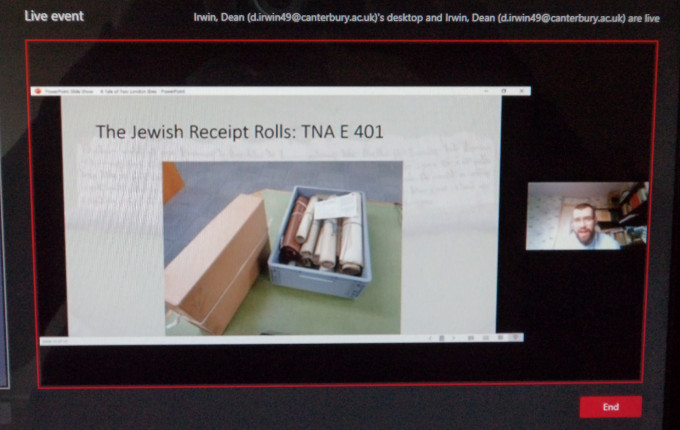
Now, as Dean was keen to point out, one of the reasons the latter have not really been looked at is a problem of identification. The pool of names used is small, the form of the name can be pretty unstable depending on the scribe and Jews moved around, having business interests in several towns. Thus are you, as the historian, actually looking at the activities on one man or not? Dean thinks he is generally right but acknowledges there may be some conflating in terms of his research that he hopes he will be able to sort this out as he gets further into his project to give these middling Jews the study they deserve. By the way the poor Jews are almost impossible to track down. They are rarely seen in the documentary sources and when they are they are almost always anonymous.
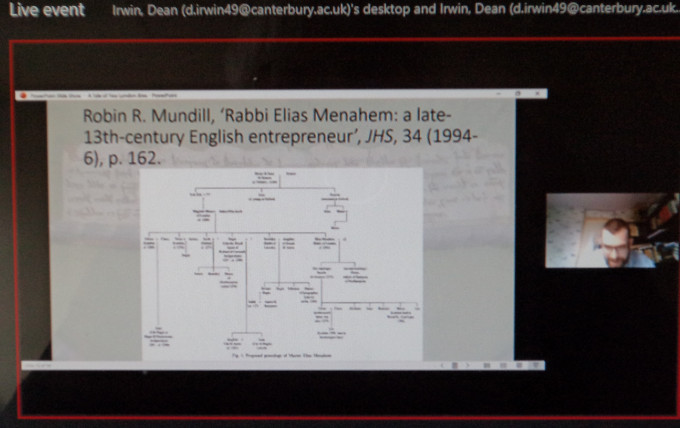
Back to Elias and Cresse, and to give an idea of their relative wealth the tallage payments each made over about a quarter of a century can be compared, Elias paid just over £455, while Cresse paid £244 and this is inflated by a payment of £101 listed in the Memoranda Rolls that isn’t in the Jewish receipt rolls as far as Dean can see. Looking more deeply into what Cresse paid when, his career seems to have begun around 1239 and it blossomed over the next decades, which is normally thought of as a time when things were becoming far more difficult for the Jewish community. Probably one of the reasons for his success is networking. As Dean pointed out he is found in the records acting on his own but equally he was often in the company of certain great Jews. This does not seem to have been a formal arrangement but a loose set of bonds and circumstances where it made business sense to work together. Evidence for such associations comes from witness lists, and similar networks seem to have occurred among the Christian community, as well as the more formal feudal relationships.
Now these two men were far more than money lenders, but it is these activities that are exceptionally well documented. Although Dean didn’t have time to go into detail, he again wanted to highlight the difference between them, and the debts owed at death demonstrate this nicely. Elias died in 1284 and he was owed over £1252 with a further £900 worth of debts he had purchased from his fellow Jews. In contrast, although Dean’s doesn’t have a comparable value at death, it seems Cresse was dealing in transactions that were valued between £400 and £450 – so you get the picture.
What other activities were they engaged in? Well, Elias was heavily engaged in a wide range of secular and religious activities, while Cresse was active in the London Jewry, often being named to jury lists and inquests, as well seemingly acting as an attorney. But it was not only these networks that mattered and familial links were also valued. Nor were such activities confined to men and Jewish women are another group who are only now being studied.
Drawing his lecture to a close, Dean was keen to point out that his new project on the ‘Mediocre History of Medieval Anglo-Jewry’ will, as he had shown day, demonstrate the complexity of Jewish society and that it is vital to investigate how different levels within that society interacted and beyond into the wider community.
Dean then took a series of question from his about 70 strong audience, including such queries and what other sources are available beyond the financial and administrative records, and what sort of length of repayment time was common at this time. Moreover, there were many appreciative comments from audience members as the session drew to a close, so thanks very much Dean for a great start to the series. And before I finish, I want to record my thanks to Dr Diane Heath for again acting as the producer and to Toby Charlton-Taylor for back-up support from the AV department.
 Centre for Kent History and Heritage
Centre for Kent History and Heritage Sheila Sweetinburgh
Sheila Sweetinburgh 1340
1340

